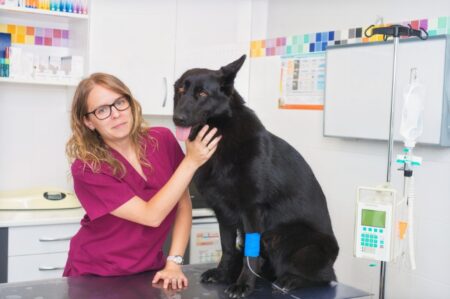The use of intravenous (IV) fluids in dogs has become a routine practice in many veterinary clinics and hospitals. However, despite its beneficial effects on the health of these furry companions, there are potential side effects that pet owners should be aware of.
In this article, we will discuss the various side effects associated with dog IV fluid administration and ways to mitigate them. Understanding these potential risks can help pet owners make informed decisions and ensure the well-being of their beloved pets during medical treatments involving IV fluids.
The Side Effects of Dog IV Fluid
Intravenous (IV) fluids are used in dogs for a variety of reasons, including dehydration, shock, and the administration of medications. While IV fluids can be extremely beneficial for dogs in need, there are also potential side effects associated with their use. These side effects can range from mild to severe and can vary based on the type of fluid, the dosage, and the individual dog’s response.
- Fluid Overload
- Electrolyte Imbalance
- Infection
- Allergic Reaction
- Phlebitis
- Edema
- Dislodgement of the IV Catheter
- Fluid Overload
One of the most common side effects of IV fluid therapy in dogs is fluid overload. This occurs when too much fluid is given too quickly, overwhelming the dog’s body’s ability to process and eliminate it. This can result in an excess of fluid in the lungs, leading to difficulty breathing, coughing, and potentially even respiratory failure.
- Electrolyte Imbalance
Some types of IV fluids contain electrolytes, which are essential for maintaining proper cellular function. If too much of these electrolytes are given, it can lead to an imbalance in the dog’s body, causing symptoms such as weakness, muscle tremors, and abnormal heart rhythm.
- Infection
The insertion of an IV catheter and the administration of fluids can create an entry point for bacteria, increasing the risk of infection. Signs of infection may include redness, swelling, and pain at the injection site, as well as fever and lethargy. If left untreated, a bacterial infection can lead to sepsis, a life-threatening condition.
- Allergic Reaction
In some cases, dogs may have an allergic reaction to the components in IV fluids, leading to symptoms such as hives, swelling of the face or throat, difficulty breathing, and collapse. It is important for veterinarians to carefully monitor dogs for signs of allergic reactions during IV fluid therapy and switch to a different type of fluid if needed.
- Phlebitis
Phlebitis is a condition characterized by inflammation of the blood vessels. It can occur when the IV catheter irritates the walls of the vein, causing redness, swelling, and pain. Severe cases can lead to the formation of blood clots, which can then travel to vital organs and cause serious complications.
- Edema
In some cases, IV fluid therapy can lead to edema, which is the accumulation of fluid in the body tissues. Edema can occur if too much fluid is administered, or if the dog’s kidneys are not functioning properly. Signs of edema may include swelling, particularly in the limbs or abdomen, and difficulty breathing.
- Dislodgement of the IV Catheter
IV catheters can sometimes become dislodged or come out completely during fluid therapy. This can lead to the fluids leaking out of the vein and into surrounding tissues, causing pain, swelling, and bruising.
What Is Dog IV Fluid?
Dog IV fluid, also known as intravenous fluid, is a clear and sterile liquid that is administered directly into a dog’s vein through a catheter. It is used to provide hydration, medications, and nutrients to dogs who are unable to drink or eat due to illness, surgery, or other medical conditions.
IV fluid can also help to maintain the correct balance of electrolytes in the dog’s body. Electrolytes are minerals such as sodium, potassium, and chloride, which are important for various bodily functions. When a dog is dehydrated or has lost electrolytes due to illness or injury, IV fluid can help restore these levels and support the dog’s overall health.
IV fluid is administered by a veterinarian or trained veterinary technician and can be given in a clinic, hospital, or at home under veterinary supervision. The type and amount of IV fluid prescribed will depend on the dog’s specific needs and condition.
Types of Dog IV Fluids
There are several types of IV fluids used for dogs, each with its specific purpose and composition. Some of the most common types include:
- Crystalloid Solutions: These are fluids that contain small, easily dissolvable electrolytes and are used to replace lost fluids and maintain hydration. Examples include normal saline (0.9% sodium chloride), lactated Ringer’s solution, and 5% dextrose in water.
- Colloid Solutions: These fluids contain larger molecules that help to maintain blood volume and prevent fluid from leaking into tissues. Examples include albumin and hetastarch.
- Hypertonic Solutions: These fluids have a higher concentration of electrolytes than the dog’s body fluids, and are used to quickly increase blood volume in cases of severe dehydration or shock. Examples include 7.5% saline and 3% saline.
- Parenteral Nutrition (TPN) Solutions: These are specialized IV fluids that contain a balanced mix of nutrients and electrolytes for dogs who are unable to eat or absorb nutrients from the digestive tract.
- Blood Products: In cases of severe anemia or bleeding disorders, blood products such as packed red blood cells, plasma, or platelets may be given through IV to help restore and maintain the dog’s blood volume.
Can IV Fluid Improve Kidney Function in Dogs?
Intravenous (IV) fluids can help improve kidney function in dogs, especially in cases of dehydration or kidney disease. IV fluids can help to flush toxins out of the body, decrease inflammation, and improve blood flow to the kidneys. They also help to maintain hydration and electrolyte balance, which is important for proper kidney function.
IV fluids may be used as a stand-alone treatment for acute kidney injury or as supportive therapy for chronic kidney disease. In both cases, the fluids can help to improve kidney function and prevent further damage to the kidneys.
SEE ALSO: My Dog Is Not Eating After Boarding: Why And What To Do
How Long Do IV Fluids Last in Dogs?
The length of time that IV fluids last in dogs will depend on several factors, such as the size and age of the dog, the reason the IV fluids were administered, and the type of IV fluids used. Generally, most IV fluids given to dogs will last anywhere from a few hours to a few days. Some IV fluids, such as ringers lactate, may only last a few hours, while other fluids, such as dextrose, can last up to 24 hours.
IV Fluids for Dogs With Parvo
Intravenous (IV) fluids are often given to dogs with parvo, a highly contagious viral disease that can cause severe dehydration and vomiting. The fluids help to replenish the dog’s body fluids and electrolytes, which can help to relieve symptoms and promote recovery. In some cases, IV fluids may be the only treatment needed for parvo, while in other cases, additional treatments, such as antibiotics, may be necessary. IV fluids can be given at a veterinary clinic or hospital, or in some cases, they can be administered at home.
Reasons For Using IV Fluids
- Rehydration: IV fluids can be used to quickly restore fluids and electrolyte balance in dogs that are dehydrated due to illness, excessive vomiting or diarrhea, or prolonged exercise.
- Administering medication: IV fluids can be used to deliver medications or supplements directly into the bloodstream, ensuring rapid absorption and effectiveness.
- Surgical support: IV fluids are often used during surgeries to maintain adequate hydration and blood pressure and to provide electrolytes and nutrients if food intake is restricted before surgery.
- Emergencies: In emergencies such as shock or severe trauma, IV fluids can be quickly administered to stabilize the dog’s condition and help prevent organ damage.
- Kidney disease: Dogs with kidney disease may have trouble maintaining proper hydration levels, and IV fluids can help support their kidney function and prevent dehydration.
- Heart disease: Dogs with heart disease may experience fluid buildup in their lungs or abdomen, and IV fluids can help to remove excess fluid and improve breathing.
- Nutritional support: In dogs that are unable to eat or have a reduced appetite, IV fluids can be used to provide nutrients and prevent malnutrition.
- Administering blood transfusions: IV fluids are commonly used to administer blood transfusions in dogs with severe anemia, blood loss, or bleeding disorders.
- Monitoring and treatment of chronic conditions: In dogs with chronic conditions such as diabetes or pancreatitis, IV fluids may be used to help manage the disease and prevent complications.
- Increased absorption of fluids: In some cases, dogs may have difficulty absorbing fluids from their gastrointestinal tract, and IV fluids can be used to bypass this issue and ensure proper hydration.
Signs of IV Fluid Overload in Dogs
- Swollen and Puffy Face: One of the most visible signs of IV fluid overload in dogs is swelling and puffiness in the face. This can be caused by an excess of fluid building up in the tissues of the face, leading to a bloated appearance. It may also be accompanied by redness or discoloration of the skin.
- Difficulty Breathing: As the excess fluid continues to accumulate, it can also put pressure on the dog’s respiratory system, making it difficult for them to breathe. This can manifest as rapid, shallow breathing, panting, or even gasping for air. It is important to seek veterinary help immediately if you notice any changes in your dog’s breathing.
- Increased Heart Rate: The heart is responsible for pumping blood around the body, and when there is an excess of fluid in the system, it has to work harder to circulate the blood. This can lead to an increased heart rate, which can be felt by placing your hand on your dog’s chest.
- Lethargy: Dogs with IV fluid overload may also appear lethargic and listless. This is because the excess fluid can make them feel heavy and uncomfortable, making it difficult for them to move or play like they usually do.
- Vomiting and Diarrhea: If the body is unable to handle the excess fluid, it may try to get rid of it through the digestive system. This can result in vomiting and diarrhea, which can further dehydrate the dog and exacerbate the fluid overload.
- Pale Gums: In severe cases of IV fluid overload, the dog may not be able to deliver enough oxygen to the body’s tissues, resulting in pale or white gums. This is a sign of poor circulation and can be life-threatening if not addressed immediately.
- Sudden Weight Gain: An increase in body weight is a common sign of fluid overload in dogs. This is because fluid accounts for a significant portion of weight gain, and dogs with IV fluid overload may gain several pounds within a short period.
Dog IV Fluids Side Effects Diarrhea
Diarrhea is a common side effect of IV fluids in dogs. This is because the IV fluids can cause the intestines to become irritated, leading to loose stools or diarrhea. In most cases, this diarrhea is not severe and should resolve on its own within a few days. However, if the diarrhea is severe or does not resolve, it is important to speak with your veterinarian. There are a few things you can do at home to help alleviate diarrhea in your dog, such as offering bland food and plenty of fresh water.
How Long Can A Dog Live On IV Fluids?
The amount of time that a dog can live on IV fluids will depend on some factors, including the severity of their illness, their age, and overall health. In some cases, a dog may only need IV fluids for a short time, such as a few days, while in other cases, they may need IV fluids for several weeks or even months.
When To See A Vet About Dogs IV Fluid Side Effects
If you notice any unusual or concerning side effects in your dog while they are receiving IV fluids, it is important to see a veterinarian right away. Some common side effects of IV fluids include vomiting, diarrhea, lethargy, or changes in appetite. If your dog is experiencing any of these side effects, they may need to have their fluid levels adjusted or may need to have their treatment plan modified.
How To Manage The Side Effects Of Dog IV Fluids
If your dog is experiencing side effects from IV fluids, there are a few things you can do to help manage them. First, make sure to follow your veterinarian’s instructions for fluid administration closely. It is also important to monitor your dog’s fluid intake and output and to keep track of any changes in their behavior or appetite. If your dog is vomiting or has diarrhea, it is important to offer them small, frequent meals of a bland diet, such as boiled chicken and rice. You may also want to try offering them a probiotic supplement to help support their digestion.
Dog IV Fluids Side Effects Treatment
- Diarrhea – If your dog experiences diarrhea after receiving IV fluids, it could be a sign of an underlying infection or an adverse reaction to the fluids. Treatment may include anti-diarrheal medication and a diet of bland, easily digestible food.
- Nausea and Vomiting – Some dogs may experience nausea or vomiting after receiving IV fluids. In this case, your vet may prescribe medication to help relieve these symptoms and may also adjust the rate of fluid administration.
- Edema – IV fluids can cause excess fluid accumulation in the tissues, known as edema. This commonly occurs in the extremities, such as the limbs, face, and abdomen. If your dog develops edema, your vet may recommend reducing the rate of fluid administration and monitoring them closely.
- Allergic Reaction – Although rare, some dogs may have an allergic reaction to certain components of the IV fluids, such as preservatives or electrolytes. Signs of an allergic reaction may include itching, swelling, hives, and difficulty breathing. Your vet will discontinue the fluids and may administer medication to treat the reaction.
- Electrolyte Imbalance – IV fluids contain electrolytes, which are essential for proper bodily function. However, if your dog receives too much or too little of certain electrolytes, it can result in an electrolyte imbalance. Treatment may include adjusting the fluid composition or administering additional electrolytes as needed.
- Infection – In rare cases, IV fluids may introduce bacteria or other microorganisms into your dog’s system, causing an infection. Signs of infection may include fever, lethargy, and loss of appetite. Your dog may require antibiotics or other medications to treat the infection.
SEE ALSO: Dog Kidney Failure: When To Euthanize Your Dog
FAQs
Q. Do IV fluids have side effects?
A. While IV fluids are generally considered to be safe, they can occasionally cause some side effects. The most common side effects include vomiting, diarrhea, and lethargy.
Q. Are IV fluids good for dogs?
A. Yes, IV fluids are often very beneficial for dogs and are frequently used to treat a variety of conditions. IV fluids can help to hydrate a dog that is dehydrated and can also be used to flush toxins from the body or deliver medications.
Q. What happens if you give a pet too much fluids IV?
A. If a pet is given too much fluids IV, it can lead to a condition called fluid overload. This can cause several problems, including pulmonary edema (fluid in the lungs), swelling of the body, and electrolyte imbalances. In severe cases, fluid overload can even be life-threatening.
Q. What does IV do to a dog?
A. When a dog is given IV fluids, the fluids are delivered directly into the dog’s bloodstream through a vein. This helps to rehydrate the dog and also allows medications and other treatments to be delivered directly into the bloodstream.
Conclusion
The use of IV fluids in dogs can have potential side effects, including infection, electrolyte imbalance, and phlebitis. It is important for pet owners to closely monitor their dog’s condition while on IV fluids and to consult with a veterinarian if any concerning symptoms arise. Alternatives to IV fluids, such as subcutaneous fluids, may be considered in certain situations. Ultimately, the decision to use IV fluids for a dog should be carefully evaluated by a veterinarian and the potential benefits and risks should be weighed.

